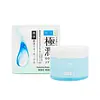What's inside
What's inside
 Key Ingredients
Key Ingredients

 Benefits
Benefits

 Concerns
Concerns

 Ingredients Side-by-side
Ingredients Side-by-side

Water
Skin ConditioningAlcohol
AntimicrobialGlycerin
HumectantNiacinamide
SmoothingButylene Glycol
HumectantDimethicone
Emollient1,2-Hexanediol
Skin ConditioningIsononyl Isononanoate
EmollientAcrylates/C10-30 Alkyl Acrylate Crosspolymer
Emulsion StabilisingPhenoxyethanol
PreservativeTromethamine
BufferingEthylhexylglycerin
Skin ConditioningDimethiconol
EmollientBetaine
HumectantXanthan Gum
EmulsifyingAdenosine
Skin ConditioningHydrogenated Lecithin
EmulsifyingTocopheryl Acetate
AntioxidantSodium Hyaluronate
HumectantPiper Methysticum Leaf/Root/Stem Extract
Skin ConditioningPhellinus Linteus Extract
Skin ConditioningHydrolyzed Hyaluronic Acid
HumectantArctium Lappa Root Extract
Skin ConditioningCitrus Medica Peel Oil
Soluble Collagen
HumectantPortulaca Oleracea Extract
Skin ConditioningPanthenol
Skin ConditioningCitrus Grandis Peel Oil
MaskingCitrus Aurantium Bergamia Fruit Oil
MaskingCitrus Aurantium Dulcis Peel Oil
MaskingPueraria Thunbergiana Root Extract
Skin ConditioningPaeonia Lactiflora Root Extract
Skin ConditioningGlycyrrhiza Glabra Root Extract
BleachingCnidium Officinale Root Extract
Skin ConditioningAloe Barbadensis Leaf Juice
Skin ConditioningHydrogenated Phosphatidylcholine
EmulsifyingRaffinose
Skin ConditioningIsostearyl Isostearate
EmollientPelargonium Graveolens Flower Oil
MaskingCholesterol
EmollientCeramide NP
Skin ConditioningFolic Acid
Skin ConditioningTocopheryl Linoleate
AntioxidantSodium Acetylated Hyaluronate
HumectantPotassium Cetyl Phosphate
EmulsifyingInulin Lauryl Carbamate
Emulsion StabilisingCedrus Atlantica Bark Oil
MaskingCananga Odorata Flower Oil
MaskingIllicium Verum Fruit/Seed Oil
MaskingCymbopogon Nardus Oil
MaskingEugenia Caryophyllus Leaf Oil
MaskingCI 42090
Cosmetic ColorantAnthemis Nobilis Flower Oil
MaskingJasminum Officinale Oil
MaskingSantalum Album Oil
MaskingFerula Galbaniflua Resin Oil
AntimicrobialRose Flower Oil
MaskingPalmitoyl Pentapeptide-4
Skin ConditioningWater, Alcohol, Glycerin, Niacinamide, Butylene Glycol, Dimethicone, 1,2-Hexanediol, Isononyl Isononanoate, Acrylates/C10-30 Alkyl Acrylate Crosspolymer, Phenoxyethanol, Tromethamine, Ethylhexylglycerin, Dimethiconol, Betaine, Xanthan Gum, Adenosine, Hydrogenated Lecithin, Tocopheryl Acetate, Sodium Hyaluronate, Piper Methysticum Leaf/Root/Stem Extract, Phellinus Linteus Extract, Hydrolyzed Hyaluronic Acid, Arctium Lappa Root Extract, Citrus Medica Peel Oil, Soluble Collagen, Portulaca Oleracea Extract, Panthenol, Citrus Grandis Peel Oil, Citrus Aurantium Bergamia Fruit Oil, Citrus Aurantium Dulcis Peel Oil, Pueraria Thunbergiana Root Extract, Paeonia Lactiflora Root Extract, Glycyrrhiza Glabra Root Extract, Cnidium Officinale Root Extract, Aloe Barbadensis Leaf Juice, Hydrogenated Phosphatidylcholine, Raffinose, Isostearyl Isostearate, Pelargonium Graveolens Flower Oil, Cholesterol, Ceramide NP, Folic Acid, Tocopheryl Linoleate, Sodium Acetylated Hyaluronate, Potassium Cetyl Phosphate, Inulin Lauryl Carbamate, Cedrus Atlantica Bark Oil, Cananga Odorata Flower Oil, Illicium Verum Fruit/Seed Oil, Cymbopogon Nardus Oil, Eugenia Caryophyllus Leaf Oil, CI 42090, Anthemis Nobilis Flower Oil, Jasminum Officinale Oil, Santalum Album Oil, Ferula Galbaniflua Resin Oil, Rose Flower Oil, Palmitoyl Pentapeptide-4
Water
Skin ConditioningDipropylene Glycol
HumectantPropanediol
SolventCeratonia Siliqua Gum
EmollientXanthan Gum
EmulsifyingChondrus Crispus Extract
Skin ConditioningChlorphenesin
AntimicrobialPEG-60 Hydrogenated Castor Oil
EmulsifyingPhenoxyethanol
PreservativePotassium Chloride
Parfum
MaskingDisodium EDTA
Hydrolyzed Hyaluronic Acid
HumectantTremella Fuciformis Sporocarp Extract
AntioxidantPlukenetia Volubilis Seed Oil
EmollientSucrose Cocoate
EmulsifyingTocopherol
AntioxidantBlue 1 Lake
Cosmetic ColorantWater, Dipropylene Glycol, Propanediol, Ceratonia Siliqua Gum, Xanthan Gum, Chondrus Crispus Extract, Chlorphenesin, PEG-60 Hydrogenated Castor Oil, Phenoxyethanol, Potassium Chloride, Parfum, Disodium EDTA, Hydrolyzed Hyaluronic Acid, Tremella Fuciformis Sporocarp Extract, Plukenetia Volubilis Seed Oil, Sucrose Cocoate, Tocopherol, Blue 1 Lake
 Reviews
Reviews

Ingredients Explained
These ingredients are found in both products.
Ingredients higher up in an ingredient list are typically present in a larger amount.
Hydrolyzed Hyaluronic Acid is a form of hyaluronic acid. It is created by the hydrolysis of hyaluronic acid with a high molecular weight. Once created, Hydrolyzed Hyaluronic Acid has a low molecular weight.
Low molecular weight HA has been shown to hydrate and increase elasticity of the skin. Increasing elasticity is also associated with reduction of wrinkle depth.
One study found topical low molecular weight hyaluronic acid may be considered for the treatment of rosacea in the adult population. However, we always recommend speaking with a professional about your skin concerns.
Hyaluronic acids are a humectant. This means they draw moisture from the air. Hyaluronic acids help moisturize, soothe, and protect the skin.
Read more about other common forms of hyaluronic acid:
Learn more about Hydrolyzed Hyaluronic AcidPhenoxyethanol is a preservative that has germicide, antimicrobial, and aromatic properties. Studies show that phenoxyethanol can prevent microbial growth. By itself, it has a scent that is similar to that of a rose.
It's often used in formulations along with Caprylyl Glycol to preserve the shelf life of products.
Water. It's the most common cosmetic ingredient of all. You'll usually see it at the top of ingredient lists, meaning that it makes up the largest part of the product.
So why is it so popular? Water most often acts as a solvent - this means that it helps dissolve other ingredients into the formulation.
You'll also recognize water as that liquid we all need to stay alive. If you see this, drink a glass of water. Stay hydrated!
Learn more about WaterXanthan gum is used as a stabilizer and thickener within cosmetic products. It helps give products a sticky, thick feeling - preventing them from being too runny.
On the technical side of things, xanthan gum is a polysaccharide - a combination consisting of multiple sugar molecules bonded together.
Xanthan gum is a pretty common and great ingredient. It is a natural, non-toxic, non-irritating ingredient that is also commonly used in food products.
Learn more about Xanthan Gum